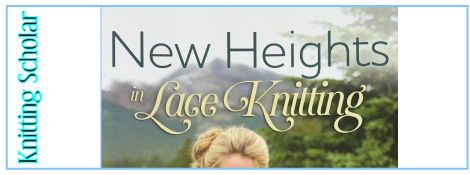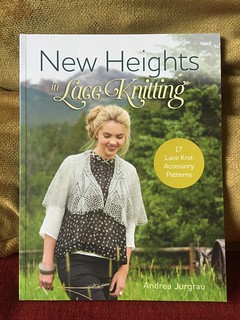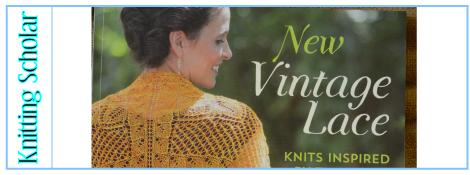First, the facts:
Title: New Heights in Lace Knitting: 17 Lace Knit Accessory Patterns
Author: Andrea Jurgrau
Published by: Interweave Press, 2016
Pages: 142
Type: Lace
Chapters:
1. Materials
2. Techniques
3. The Fine Art of Swatching
4. Projects: Hikes, Treks, and Moderate Climbs
5. Projects: The Seven Summits
6. Projects: The Eight Summit
The In-Depth Look:
A new lace book from the person who brought me one of my favorite recent lace books, New Vintage Knits.
The lace patterns here are inspired by mountain peaks. She says at the beginning:
“The lore of the seven summits calls to every mountaineer … Summiting a mountain always begins with a few simple steps. And as it is with climbing, so it is with knitting. Basic knit, purl, and yarnover stitches can come together to make lace that is simple but elegant; and, for those seeking further adventures, these very same stitches can unfold into spectacular designs. So I think of this book as a knitter’s approach to the seven summits. It is proverbial mountain climbing for lace knitters who are adventurous; delighted by the basics, yet yearning for more.”
True to her word, the projects here range from simple (hikes, treks and moderate climbs) to “The seven summits,” representing the tallest peak on each of the seven continents, and challenging the knitter accordingly.
The lace here is gorgeous–which didn’t surprise me at all. There are easier projects, like lace mitts or hats that correspond to a gentle hike on a lovely day, but then there are the challenging ones … big, complex, show-stopper shawls that are challenges worthy of their names.
If I have any complaints about this book, it’s that the charts can be rather small. Some of the more complex shawls have charts that span pages in the book, which I think must make them a complicated challenge to knit. The size of the squares and the symbols in the squares makes for its own challenge. I don’t quite see how the book could be published differently, but wish there were some way for a knitter to get an enlarged, easy-to-read chart. Maybe a downloadable PDF with enlarged versions of individual charts? Copy machines and scotch tape can only do so much! (And I mention this because there was a shawl in her last book, New Vintage Lace that I would love to knit, but trying to manipulate the charts into something easily usable is daunting–and I’m not the kind of knitter who’s afraid of charts!)
That said, this is a beautiful book, with some amazing lace projects–most of whom do have perfectly good charts. (It’s just a few that have so-large-they’re-too-small layout problems.) Gorgeous designs, as inspiring as the peaks they’re named for.
You should look for this book at your local shop–or at Amazon, where your purchase can help support this site!
Want to see bigger pictures? Click here.

This review copy was kindly donated by Interweave Press. Thank you!
Other posts for this author:







